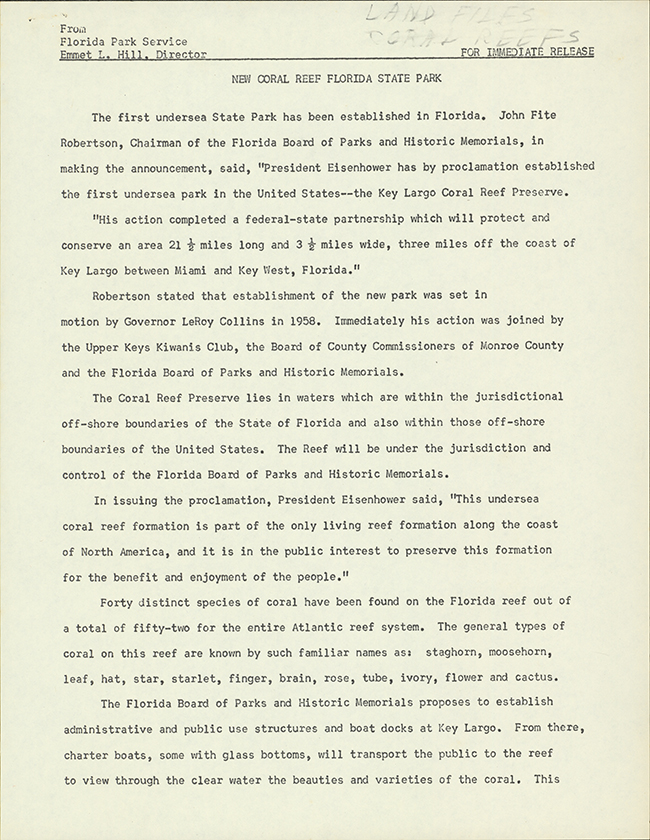The History of Water in Florida
Press Release from the Florida Park Service Regarding John Pennekamp State Park (ca. 1960)
From: Florida Board of Parks and Historic Memorials, Public relations and historical files, 1934-1964 (Series 1951, Box 2, Folder 58)
John Pennekamp State Park was the United States' first underwater park. It was dedicated in 1960. The following press release from Florida Park Service Director Emmet L. Hill describes the state's plans for the park and how the project was made possible.

From
Florida Park Service
Emmet L. Hill, Director
FOR IMMEDIATE RELEASE
NEW CORAL REEF FLORIDA STATE PARK
The first undersea State Park has been established in Florida. John Fite Robertson, Chairman of the Florida Board of Parks and Historic Memorials, in making the announcement, said, "President Eisenhower has by proclamation established the first undersea park in the United States -- the Key Largo Coral Reef Preserve.
"Hi action action completed a federal-state partnership which will protect and conserve an area 21 1/2 miles long and 3 1/2 miles wide, three miles off the coast of Key largo between Miami and Key West, Florida."
Robertson stated that establishment of the new park was set in motion by Governor LeRoy Collins in 1958. Immediately his action was joined by the Upper Keys Kiwanis Club, the Board of County Commissioners of Monroe County and the Florida Board of Parks and Historic Memorials.
The Coral Reef Preserve lies in waters which are within the jurisdictional off-shore boundaries of the State of Florida and also within those off-shore boundaries of the United States. The Reef will be under the jurisdiction and control of the Florida Board of Parks and Historic Memorials.
In issuing the proclamation, President Eisenhower said, "This undersea coral reef formation is part of the only living reef formation along the coast of North America, and it is in the public interest to preserve this formation for the benefit and enjoyment of the people."
Forty distinct specieis of coral have been found on the Florida reef out of a total of fifty-two for the entire Atlantic reef system. The general types of coral on this reef are known by such familiar names as: staghorn, moosehorn, leaf, hat, star, starlet, finger, brain, rose, tube, ivory, flower and cactus.
The Florida Board of Parks and Historic Memorials proposes to establish administrative and public use structures and boat docks at Key Largo. From there, charter boats, some with glass bottoms, will transport the public to the reef to view through the clear water the beauties and varieties of the coral. This
[page 2]
exotic garden of nature's marine growth will be laid out in pathways which the boats will follow as though through a flowering garden or forest.
Provisions will be made for underwater photography and possibly short walking tours along the reef floors at low tides.
In any event, the destruction formerly caused by commercial shell, coral and gorgonia hunters, color fish collectors who must overturn natural rock and growing coral to get into the deep pockets to reach their quarry, and those who would use explosives, has been stopped. Commercial and sport fishing (without spear fishing), cruising, and other recreational activities will not be restricted.
The United States Department of the Interior, the Trustees of the Internal Improvement Fund, the State Board of Conservation, and the Florida Board of Parks and Historic Memorials mutually worked on laying the ground work for this most unique cooperative conservation movement.
In 1959 the Trustees of the Internal Improvement Fund dedicated for park recreational and preservation purposes certain lands within the boundary of the Key Largo Coral Reef Preserve.
The President's proclamation completed the establishment of the nation's newest and most unusual park.
**********
Photo by Herb Alley ...... Tavernier, Florida

 Listen: The Folk Program
Listen: The Folk Program